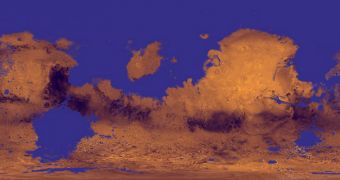Over the past few years, planetary scientists and geologists have become convinced that an ocean of liquid water once existed on the Red Planet. A new study now proposes an interesting explanation for how the body of water may have developed.
According to investigators at the Tucson, Arizona-based Planetary Science Institute (PSI), motions in the groundwater on Mars were the main reason why lakes and seas most likely accumulated.
The group, led by research scientist J. Alexis Palmero Rodriguez, says that extensive and widespread fractures that developed in the floors of ancient basins on the planet are what allowed for groundwater to seep to the surface.
Based on what we already know about Martian geology, these basins would have been as large as continents. The research was carried out on an area located in the northern plains, located south of Gemini Scopuli, in Planum Boreum.
These northern lowlands are similar to the area that the Phoenix Mars Lander visited back in 2008, when it managed to identify signs of water-ice just a few millimeters below the sand-covered Martian surface.
The team says that these regions stand out because they contain extensive sedimentary deposits, that bear a striking resemblance to the ones found at the bottom of abyssal plains on our oceans' floors.
Rodriguez believes that the groundwater seepage that took place billions of years ago triggered the development of other indicative landscape features, such as for example sedimentary deposition, water ponding, large-scale regional erosion patterns and river systems, SpaceRef reports.
“With the loss over time of water from the subsurface aquifer, areas of the northern plains ultimately collapsed, creating the rough hilly surfaces we see today,” the team leader says.
“Some plateaus may have avoided this fate and preserved sedimentary plains containing an immense record of hydrologic activity,” he adds.
“The geologic record in the collapsed hilly regions would have been jumbled and largely lost,” Rodriguez goes on to say.
“This model implies that groundwater discharges within basin settings on Mars may have been frequent and led to formation of mud pools, lakes and oceans. In addition, our model indicates this could have happened at any point in the planet's history,” he concludes.

 14 DAY TRIAL //
14 DAY TRIAL //